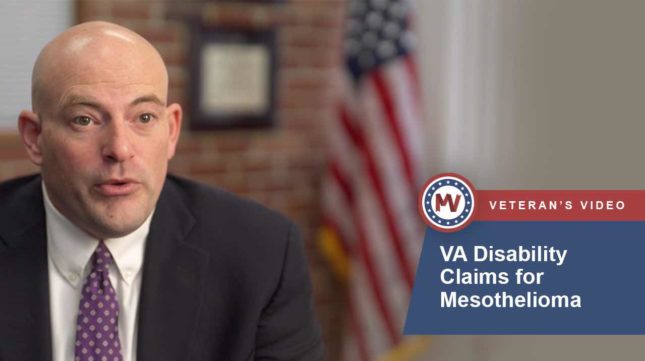Veterans with mesothelioma can file for disability benefits — or get a higher disability payout — from the VA after a diagnosis. Mesothelioma disability claims pay a minimum of $3,946.25 per month for married veterans. File mesothelioma disability claims or increase your VA disability compensation with our help.
File or Increase VA Disability
VA Disability for Veterans With Mesothelioma
U.S. Department of Veterans Affairs (VA) disability benefits offer monthly tax-free payouts to veterans with health problems caused or worsened by military service. It’s one of many VA benefits offered to veterans.
Many U.S. veterans with malignant mesothelioma qualify for VA disability compensation if they were exposed to asbestos (the only known cause of this cancer) while serving. All branches of the military used asbestos through the early 1980s without knowing the risks.
In 2024, U.S. veterans who are married can get $3,946.25 or more each month through mesothelioma disability claims. This is because veterans fighting this cancer typically receive the highest disability ratings.
Video Summary: VA-accredited attorney Eric Hall explains how veterans with mesothelioma can get monthly VA disability compensation from the VA often worth $3,946.25 or more a month. View Transcript
A disability claim is monthly compensation that a veteran is entitled to if they've been disabled as a result of their service in the military. Veterans who have been diagnosed with mesothelioma as a result of their service in the military are likely to receive a benefit of $3,500 of monthly income tax-free to the veteran.
If a veteran believes they were exposed to asbestos while serving in the military, we encourage them to call the Mesothelioma Veterans Center so that we can work together to help them file for VA benefits.
The Mesothelioma Veterans Center can help you file mesothelioma disability claims or increase your disability rating so you can get more compensation. Get started right now.
How Much VA Disability Can You Get for Mesothelioma Cancer?
The VA pays out different amounts of monthly compensation by assigning a disability rating for the health problem(s) a veteran has.
U.S. veterans with mesothelioma are almost always granted a 100% disability rating and receive the highest payouts since this cancer is so aggressive.
| Disability Rating | Base Monthly Payout | Monthly Payout With Spouse |
|---|---|---|
| 10% | $171.23 | $171.23 (no change) |
| 20% | $338.49 | $338.49 (no change) |
| 30% | $524.31 | $586.31 |
| 40% | $755.28 | $838.28 |
| 50% | $1,075.16 | $1,179.16 |
| 60% | $1,361.88 | $1,486.88 |
| 70% | $1,716.28 | $1,861.28 |
| 80% | $1,995.01 | $2,161.01 |
| 90% | $2,241.91 | $2,428.91 |
| 100% (mesothelioma rate) | $3,737.85 | $3,946.25 |
Eligible veterans with several dependents or whose spouses are receiving aid and attendance (an additional VA financial benefit) can receive higher payments.
Can I Increase My VA Mesothelioma Disability Compensation?
Yes. If you already receive VA disability compensation at a lower rating, you can increase your payout following a mesothelioma diagnosis. To do so, you’ll need to file an additional VA claim.
Even a 50% disability rating pays out less than a third of the compensation available from a 100% disability rating for mesothelioma. This means you may be able to access thousands of dollars more each month to help you and your family.
The Mesothelioma Veterans Center has VA-accredited claims agents on staff who can help you increase your disability rating to get more mesothelioma compensation. Contact us now to get started.
Is My VA Disability Compensation Taxable?
No. According to the VA, disability compensation is not taxed. This means you and your family will get this monthly benefit without worrying about taxes reducing the payouts you receive.
Who Can File Mesothelioma Disability Claims?
U.S. veterans can file mesothelioma VA disability claims after a diagnosis. They will likely need to file it as a postservice claim. Since mesothelioma takes 10-50 years after asbestos exposure to develop, most veterans are diagnosed long after serving.
If they have proper authority, loved ones may be able to file a VA mesothelioma disability claim on a veteran’s behalf.
Surviving spouses and family cannot file disability claims for themselves, but they can get VA Dependency and Indemnity Compensation (VA DIC). This provides monthly payments to family members if a veteran dies on active duty or from a service-connected condition like mesothelioma.
File for all the mesothelioma VA benefits you deserve right now with our help.
Steps to File Mesothelioma Disability Claims
Follow the steps below to file your VA mesothelioma disability claim. You can also follow these steps to file a claim for increased mesothelioma compensation after a diagnosis.
1. Check Eligibility Requirements
There are three basic requirements for VA disability:
- You have an injury, illness, or disability.
- You served on active duty (or underwent active/inactive duty training).
- You can prove that your condition is linked to your service.
“The VA will recognize any asbestos-related disease as long as your asbestos exposure happened while you were on active duty in the military.”
— Eric Hall, Major USAFR and VA Attorney
2. Put the VA on Notice
Inform the VA that you intend to file for VA disability benefits. Call (877) 450-8973 and connect with us to get started — we can put you in contact with the VA to put them on notice.
Once this is done, it will “start the clock” on your claim. As a result, once your VA mesothelioma disability claim is approved, you may receive several months’ worth of back pay through a lump-sum payment.
From there, you can work with our team to properly file your claim and get the highest disability payouts possible.
3. Gather Evidence


Several types of evidence can be presented, including:
- Medical records confirming your diagnosis
- Military records showing when and where you served
- Proof that you worked with or around asbestos, such as records of specific job duties
- A letter from your mesothelioma specialists linking your diagnosis to military asbestos exposure
The Mesothelioma Veterans Center team can help you prove when, where, and how you were exposed to asbestos in the military and guide you through the claims process. Contact us today to get help.
4. File the Claim
Submit the main disability compensation application (VA Form 21-526EZ) and evidence to a VA office online, by mail, or with the help of a VA-accredited agent or mesothelioma lawyer.
It’s best to file your mesothelioma disability claim as soon as possible. By doing so, you can start getting payments quicker. Otherwise, you could miss out on collecting tens of thousands of dollars.
The Mesothelioma Veterans Center can make sure mesothelioma disability claims and supporting evidence are filed correctly.
5. Receive Benefits After VA Review
Once your claim is filed, the VA will review it and decide whether or not to award mesothelioma disability compensation or grant you a higher disability rating, depending on the case.
It takes an average of 158 days for the VA to decide on a disability claim as of February 2024.
However, the Mesothelioma Veterans Center can speed up the process in some cases. Work with our team to file mesothelioma disability claims now and get the financial aid you and your family need.
What Can Mesothelioma Disability Compensation Be Used For?
You can use compensation from mesothelioma VA disability claims for anything once you start receiving it.
Mesothelioma disability compensation can help pay for:
- Mesothelioma treatment
- In-home caregiving services
- Living expenses (mortgage, rent, grocery bills)
- Lost wages
Getting VA disability compensation for mesothelioma is very important, because you may face high treatment costs, travel fees, and other expenses as you battle this cancer. Sometimes, a family member must stop working to assist with your care.
When you work with the Mesothelioma Veterans Center, we’ll ensure that you get the highest amount of financial compensation possible in your case. We can also help you explore other compensation options if disability payouts won’t cover all your expenses.
Start Your VA Mesothelioma Disability Claim Now
If you or a loved one proudly served in the U.S. military and now suffer from mesothelioma, the Mesothelioma Veterans Center stands ready to help you access VA disability compensation.
Remember, mesothelioma disability claims typically award $3,946.25 each month — or $47,355 per year. This life-changing, tax-free compensation provides security and stability following a cancer diagnosis.
With our team, you can:
- File mesothelioma disability claims
- Increase your disability rating if you already have VA disability
- Pursue other forms of mesothelioma compensation
Call (877) 450-8973 to connect with our team and file a mesothelioma disability claim right now.
Mesothelioma Disability Claims FAQs
Does mesothelioma qualify for disability?
Yes. Veterans with mesothelioma qualify for VA disability compensation if they were exposed to asbestos while serving in the U.S. military. Asbestos exposure can cause mesothelioma 10-50 years later.
Contact our team now to find out your eligibility and file mesothelioma disability claims.
What is the average payout for a mesothelioma claim?
Mesothelioma VA disability claims pay out $3,737.85 each month for single veterans and $3,946.25 per month for married veterans.
You may also be able to file private claims for mesothelioma, which are worth $1 million or more on average and won’t affect your eligibility for veterans benefits like disability.
What can I claim for with mesothelioma?
You can claim VA disability compensation, as well as other military and financial benefits, following a diagnosis.
The VA offers disability compensation for mesothelioma, asbestosis, and asbestos lung cancer. The military used asbestos in U.S. Navy ships and shipyards, Air Force planes, and bases, so former service members are at high risk of asbestos-related diseases today.
Companies sold asbestos-based products to the military but failed to warn of the risks of asbestos exposure. Thus, it’s possible to file claims against these companies to get more compensation on top of VA benefits.
What happens if my mesothelioma disability claim is denied?
If your mesothelioma VA claim is rejected, you may request a decision review through one of three VA appeal options: a supplemental claim, a higher-level review, or a board appeal.
Certain appeal options may be more or less effective depending on the VA’s reason for rejecting mesothelioma VA disability claims.
How do I check on my mesothelioma VA disability claim?
You can check the status of your VA mesothelioma disability claim online or by calling the VA. You can also use the same methods to check the status of a VA appeal.



